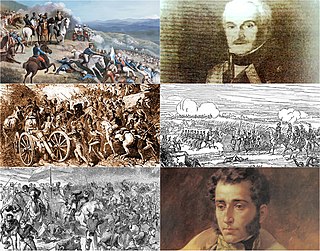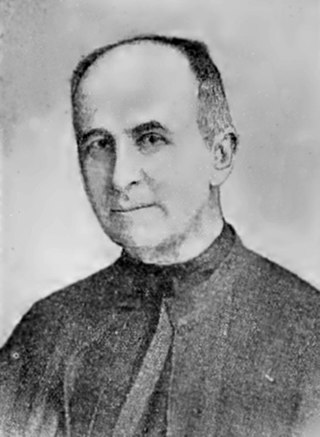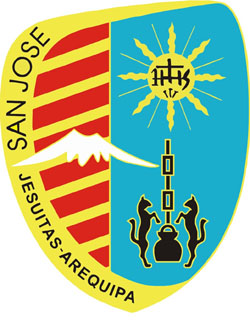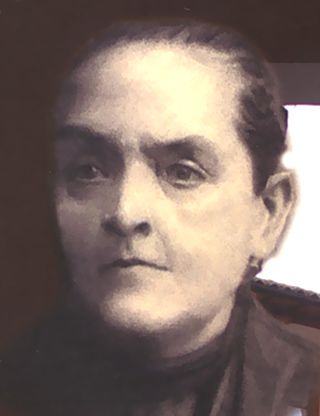
Quito, officially San Francisco de Quito, is the capital of Ecuador, with an estimated population of 2.8 million in its metropolitan area. It is also the capital of the province of Pichincha. Quito is located in a valley on the eastern slopes of Pichincha, an active stratovolcano in the Andes.

Ambato is a city located in the central Andean valley of Ecuador. Lying on the banks of the Ambato River, the city also sits beneath several tall mountains. It is the capital city of the Tungurahua Province, situated at an elevation of 2,577 meters above sea level. It is variously nicknamed "City of Flowers and Fruits", "Land of the Three Juan's", and "Garden of Ecuador." Ambato's inhabitants are called Ambateños or Guaytambos. The current mayor of Ambato is Diana Caiza.

Gabriel Gregorio Fernando José María García Moreno y Morán de Butrón, was an Ecuadorian politician and aristocrat who twice served as President of Ecuador and was assassinated during his second term after being elected to a third. He is noted for his conservatism, Catholic religious perspective and rivalry with liberal strongman Eloy Alfaro. García Moreno was noted for efforts to economically and agriculturally advance Ecuador and for his staunch opposition to corruption.

Riobamba is the capital of Chimborazo Province in central Ecuador, and is located in the Chambo River Valley of the Andes. It is located 200 km (120 mi) south of Ecuador's capital Quito and situated at an elevation of 2,754 m.

The Ecuadorian War of Independence, part of the Spanish American wars of independence of the early 19th century, was fought from 1809 to 1822 between Spain and several South American armies over control of the Real Audiencia of Quito, a Spanish colonial jurisdiction which later became the modern Republic of Ecuador. The war ended with the defeat of the Spanish forces at the Battle of Pichincha on May 24, 1822, which brought about the independence of all the lands of the Real Audiencia of Quito.

Pedro Vicente Maldonado y Flores was an Ecuadorian scientist who collaborated with the members of the French Geodesic Mission. As well as a physicist and a mathematician, Maldonado was an astronomer, topographer, and geographer.

Franz Theodor Wolf was a German naturalist who studied the Galápagos Islands during the late nineteenth century. Wolf Island is named after him. The peak Volcán Wolf on Isabela Island is also named after him. He was born at Bartholomä.

Luis Sodiro (1836–1909) was an Italian Jesuit priest and a field botanist from Vicenza who described a large number of species from the area around Quito, Ecuador in the early 20th century. He was perhaps the first person who collected in this region and he described at least 38 species from Esmeraldas, a region in Ecuador.
The National Polytechnic School, also known as EPN, is a public university in Quito, Ecuador. The campus, named after José Rubén Orellana, is located in the east-central part of Quito. It occupies an area of 15.2 hectares and has a built area of around 62,000 metres2. Its student body numbers approximately 10,000, of which thirty percent are women. The main campus encompasses ten teaching and research faculties, in addition to four technical and specialized institutes. EPN was founded in 1869 with the aim of becoming the first technical and technological center in the country. Since its beginnings, EPN adopted the polytechnic university model, which stresses laboratory instruction in applied science and engineering. At the campus, there are some libraries with content primarily oriented to engineering and scientific topics.

Colegio San José is a private Catholic pre-school, primary and secondary school, located in Arequipa, Perú. The selective school was founded in 1898 by the Society of Jesus and excels in academics and athletics. As of 2013, Colegio San José was one of 22, that received an "excellent" rating.

The Church and Convent of San Ignacio de Loyola de la Compañía de Jesús de Quito, also known in the Ecuadorian people simply as La Compañía, is a Catholic clerical complex located on the corner formed by calles García Moreno and Sucre, in the Historic Center of the city of Quito, capital of Ecuador. The façade of its main temple is entirely carved in volcanic stone. Over time, this church has also been called: "Temple of Solomon of South America". Father Bernardo Recio, a traveling Jesuit, called it "Golden Ember".

La Iglesia de El Sagrario is a Renaissance Catholic Church in the city of Quito, capital of Ecuador. It is located in the Historic Center of the city, on calle García Moreno, formerly known as calle de las Siete Cruces, a few meters from the corner with calle Eugenio Espejo. It is part of the Metropolitan Cathedral complex, although it seems more like an independent church than an adjoining chapel, both because of its size and because of its importance in Quito's art.
Christ the King School is a private Catholic primary and secondary school, located in Portoviejo, Ecuador. Established in 1930 as a seminary run by the Society of Jesus, the school grew to be pre-primary through high school, and serves the needier segment of society.

St. Francis Xavier College is a private Catholic primary and secondary school, located in Puerto Montt, Chile. Founded by the Society of Jesus in 1859, the school is affiliated with the Ignatian Educational Network of Chile and the Latin American Federation of the Society of Jesus (FLACSI). One of the oldest schools in Chile, it originally served the immigrant German colony in southern Chile.

St. Ignatius College, Santiago is a private Catholic primary and secondary school, located in Santiago, Chile. The school was founded by the Society of Jesus in 1856 and is run by the Jesuit St. Ignatius Foundation as a part of the Ignatian Educational Network of Chile, the Latin American Federation of Jesuit Colleges, and the Latin American Federation of the Society of Jesus (FLACSI).

Colegio Mayor de San Bartolomé is a private Catholic pre-school, primary and secondary school, colonial of Plateresque style building, located in the Santa Fe district of Bogotá, Cundinamarca, Colombia. The co-educational school was founded on 27 September 1604 by the Archbishop of Bogota Bartolomé Lobo Guerrero and the Jesuits José Dadey, Martín de Funes, Juan Bautista Coluccini, Martín de Torres, Bernabé de Rojas, and Diego Sánchez. The school is managed by the Society of Jesus.

Xavier College, Tudela is a private Catholic secondary school, located in Tudela, Navarre, Spain. Founded by the Society of Jesus in 1891, the school prepares students for the Spanish Baccalaureate, and has specialist departments for special education and for special vocational training. Compañía de María primary school serves as a feeder school for Xavier College.

San Jose College is a private Catholic primary and secondary school, located in Valladolid, in the autonomous community of Castile and León, Spain. The school was founded by the Society of Jesus in 1881 and teaches pre-primary, primary, high school (ESO), and baccalaureate. Designed by Ortiz de Urbina, the school building is considered a good example of the eclecticism of the time.

Luis Cadena was an Ecuadorian painter. He worked principally in portraiture but also painted many religious subjects for the Roman Catholic Church. He was appointed director of the Academia de Dibujo y Pintura in Quito in December 1860 and served as director of the Escuela de Bellas Artes of the same city from 1872 to 1875.

Juana Miranda Petrona was an Ecuadorian obstetrician and the first female university professor in Ecuador.



















